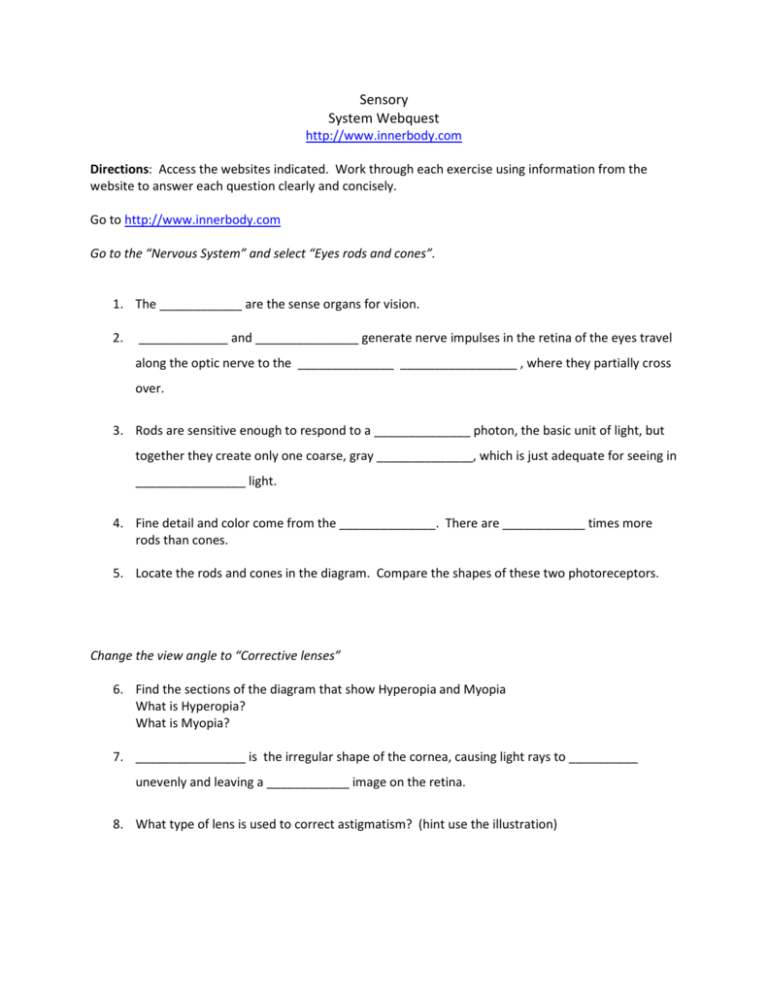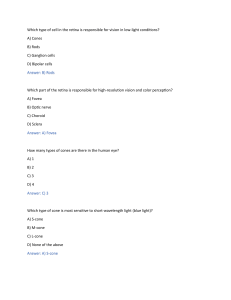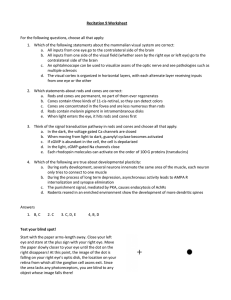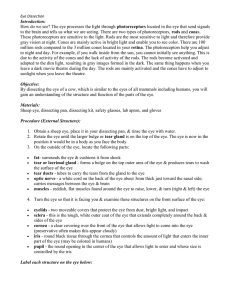Sensory System Webquest: Eyes, Ears, Taste
advertisement

Sensory System Webquest http://www.innerbody.com Directions: Access the websites indicated. Work through each exercise using information from the website to answer each question clearly and concisely. Go to http://www.innerbody.com Go to the “Nervous System” and select “Eyes rods and cones”. 1. The ____________ are the sense organs for vision. 2. _____________ and _______________ generate nerve impulses in the retina of the eyes travel along the optic nerve to the ______________ _________________ , where they partially cross over. 3. Rods are sensitive enough to respond to a ______________ photon, the basic unit of light, but together they create only one coarse, gray ______________, which is just adequate for seeing in ________________ light. 4. Fine detail and color come from the ______________. There are ____________ times more rods than cones. 5. Locate the rods and cones in the diagram. Compare the shapes of these two photoreceptors. Change the view angle to “Corrective lenses” 6. Find the sections of the diagram that show Hyperopia and Myopia What is Hyperopia? What is Myopia? 7. ________________ is the irregular shape of the cornea, causing light rays to __________ unevenly and leaving a ____________ image on the retina. 8. What type of lens is used to correct astigmatism? (hint use the illustration) Go to the “Nervous System” and select “Ears and hearing”. 9. Find the structure of the ear called the cochlea. What is it shaped like? 10. What is the function of the cochlea? 11. Find the tympanic membrane. What is it’s function? 12. What is the auricle? 13. What are the names of the bones of the middle ear? Go to the “Nervous System” and select “Taste buds”. 14. __________ _____________ are special structures that detect ___________. We have about __________ taste buds, mainly on the tongue with a few at the __________ of the throat. 15. List the four common taste receptors, where they are located and an example of a substance that will trigger them. a. b. c. d. Go to http://www.eschoolonline.com/company/examples/eye/eyedissect.html Click on the “Eye anatomy” button (under the picture of the eye) to see the external parts of the eye. 16. List the parts of the external eye that you were able to click on. Click on the “View sliced eye” button to see the internal parts of the eye. 17. List the parts of the internal eye that you were able to click on Click on the “close window” button, and find the buttons under “Eye Parts”. Click on each one and read the information (don’t forget the arrow next to each picture to advance to multiple pages) in order to answer the following questions: 18. What determines how clear the lens appears? 19. What does the word vitreous mean? 20. Why do you think the cornea should be clear? 21. What does the iris do in order to control the amount of light entering the eye? 22. What is the white part of the eyeball? 23. Based on the picture showing the retina, what nervous tissue do you think it is connected to? 24. What does the small puddle of the aqueous humor remind you of? Click on the “Begin Dissection” line and complete the dissection. Make sure to drag the parts that are removed to the correct box.











